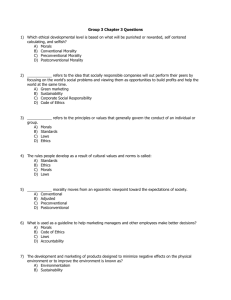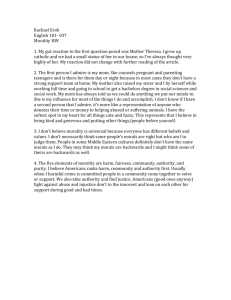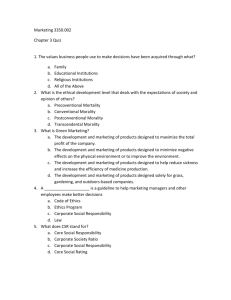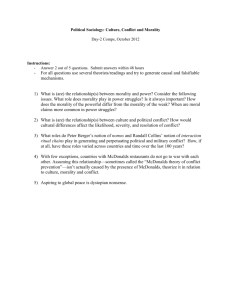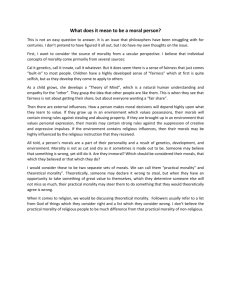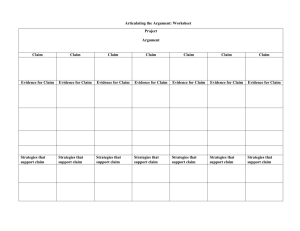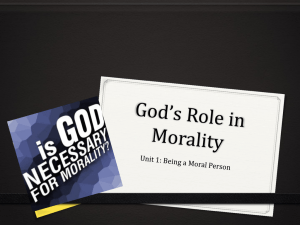1. The term ______ refers to the moral principles or values that
advertisement
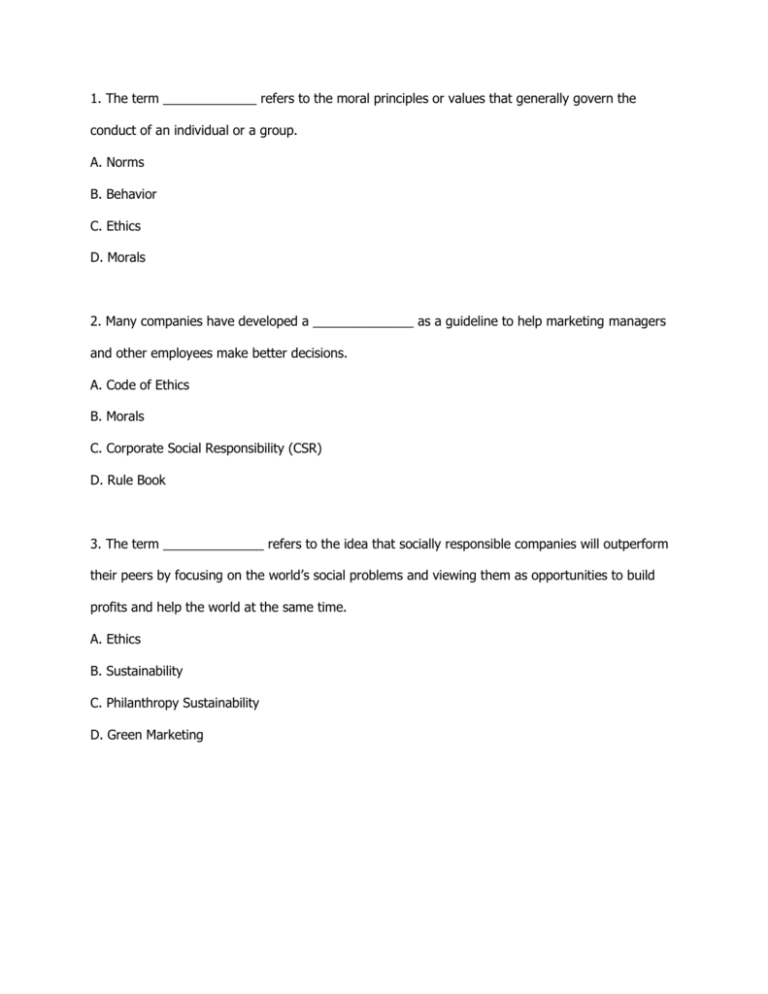
1. The term _____________ refers to the moral principles or values that generally govern the conduct of an individual or a group. A. Norms B. Behavior C. Ethics D. Morals 2. Many companies have developed a ______________ as a guideline to help marketing managers and other employees make better decisions. A. Code of Ethics B. Morals C. Corporate Social Responsibility (CSR) D. Rule Book 3. The term ______________ refers to the idea that socially responsible companies will outperform their peers by focusing on the world’s social problems and viewing them as opportunities to build profits and help the world at the same time. A. Ethics B. Sustainability C. Philanthropy Sustainability D. Green Marketing 4. What is the ethical development level that deals with the expectations of society and opinion of others? A) Preconventional Morality B) Conventional Morality C) Postconventional Morality D) Transcendental Morality 5. A code of ethics: A) Helps identify acceptable business practices, controls behavior internally, and fundamentally leads to better decisions. B) Should not be too vague or too detailed C) Both A and B D) None of the above 6. Which of the following is the most basic level of ethical development? a. Conventional morality b. Post conventional morality c. Preconventional morality d. None of the above 7. ________ is the development of products designed to minimize negative effects on the physical environment or to improve the environment? A) Social Responsibility B) Green Marketing C) United Nations Global Compact D) None of the above 8. Ethics can be defined as: A. The moral principles or values that generally govern the conduct of an individual or group. B. The standard of behavior by which conduct is judged. C. Personal moral principles D. All the above 9. Which of the following questions does not help develop a personal set of ethics? A. Who is helped or hurt? B. How much work do I have to do? C. What are the consequences? D. What will provide the most benefit? 10.Which of the following is NOT an example of green products? A. Compact fluorescent light bulbs B. Hybrid engines C. Batteries D. Organic beef ANSWERS 1. 2. 3. 4. 5. 6. 7. 8. 9. 10. C A B B C C B D B C 1. Which is NOT an influential factor in ethical decision making? A. Probability of Harm B. Potential Consequences C. Financial Benefits D. Social Consensus 2. What’s a businesses concern for societal welfare? A. FCPA B. CSR C. Pyramid of Corporate Social Responsibility D. Sustainability 3. The moral principles or values that generally govern the conduct of an individual of an individual or a group in known as: A. B. C. D. The conscience Morals Ethics None of the above 4. The greater the harm done to victims, the more likely it is that marketing professionals will recognize a problem as unethical involves which factor that influences ethical decision making and judgements? A. B. C. D. Length of Time Potential Magnitude of consequences Probability of harmful outcome Number of people to be affected 5. The foundation for the Pyramid of Corporate Social Responsibility is which of the following? A. B. C. D. Economic responsibilities Legal responsibilities Ethical responsibilities Philanthropic responsibilities 6. Green Marketing is… A. A controversial subset of social responsibilities B. The newest theory in social responsibility. C. An outgrowth of the social responsibility movement. D. The development and marketing of products designed to minimize negative effects on the physical environment or to improve the environment. E. Both C & D 7. What defines Morals? A. B. C. D. Good behavior Bad behavior Deviant behavior All the Above 8. Which of the following lists the ethical development levels in order of most childlike to most mature? A. Conventional Morality, Preconventional Morality, Postconventional Morality B. Preconventional Morality, Conventional Morality, Postconventional Morality C. Postconventional Morality, Preconventional Morality, Conventional Morality D. None of the above 9. How much does Cause-Related Marketing generate annually? A. $10 billion B. $4 billion C. $7 billion D. $1 billion 10. What is an advantage to create a code of ethics? A. Guidelines help employees identify what their firm recognizes as business acceptable practices. B. To outperform their peers and companies. C. To have a sustainable company. D. To create an extremely detailed list of rules what employees can and can’t do. Answers 1. 2. 3. 4. 5. 6. 7. 8. 9. A C B C B A E D B C
